
A ceramic is any of the various hard, brittle, heat-resistant, and corrosion-resistant materials made by shaping and then firing an inorganic, nonmetallic material, such as clay, at a high temperature. Common examples are earthenware, porcelain, and brick.

Pottery is the process and the products of forming vessels and other objects with clay and other raw materials, which are fired at high temperatures to give them a hard and durable form. The place where such wares are made by a potter is also called a pottery. The definition of pottery, used by the ASTM International, is "all fired ceramic wares that contain clay when formed, except technical, structural, and refractory products". End applications include tableware, decorative ware, sanitary ware, and in technology and industry such as electrical insulators and laboratory ware. In art history and archaeology, especially of ancient and prehistoric periods, pottery often means vessels only, and sculpted figurines of the same material are called terracottas.

Raku ware is a type of Japanese pottery traditionally used in Japanese tea ceremonies, most often in the form of chawan tea bowls. It is traditionally characterised by being hand-shaped rather than thrown, fairly porous vessels, which result from low firing temperatures, lead glazes and the removal of pieces from the kiln while still glowing hot. In the traditional Japanese process, the fired raku piece is removed from the hot kiln and is allowed to cool in the open air.
The Sicarii were a splinter group of the Jewish Zealots who, in the decades preceding Jerusalem's destruction in 70 CE, strongly opposed the Roman occupation of Judea and attempted to expel them and their sympathizers from the area. The Sicarii carried sicae, or small daggers, concealed in their cloaks. At public gatherings, they pulled out these daggers to attack Romans and alleged Roman sympathizers alike, blending into the crowd after the deed to escape detection.

In materials science, a refractory is a material that is resistant to decomposition by heat or chemical attack that retains its strength and rigidity at high temperatures. They are inorganic, non-metallic compounds that may be porous or non-porous, and their crystallinity varies widely: they may be crystalline, polycrystalline, amorphous, or composite. They are typically composed of oxides, carbides or nitrides of the following elements: silicon, aluminium, magnesium, calcium, boron, chromium and zirconium. Many refractories are ceramics, but some such as graphite are not, and some ceramics such as clay pottery are not considered refractory. Refractories are distinguished from the refractory metals, which are elemental metals and their alloys that have high melting temperatures.

Ceramics of Indigenous peoples of the Americas is an art form with at least a 7500-year history in the Americas. Pottery is fired ceramics with clay as a component. Ceramics are used for utilitarian cooking vessels, serving and storage vessels, pipes, funerary urns, censers, musical instruments, ceremonial items, masks, toys, sculptures, and a myriad of other art forms.

A saggar is a type of kiln furniture. It is a ceramic boxlike container used in the firing of pottery to enclose or protect ware being fired inside a kiln. The name may be a contraction of the word safeguard.

Olive oil extraction is the process of extracting the olive oil present in olive drupes. Olive oil is produced in the mesocarp cells, and stored in a particular type of vacuole called a lipo vacuole, i.e., every cell contains a tiny olive oil droplet. Olive oil extraction is the process of separating the oil from the other fruit contents. It is possible to attain this separation by physical means alone, i.e., oil and water do not mix, so they are relatively easy to separate. This contrasts with other oils that are extracted with chemical solvents, generally hexane. The first operation when extracting olive oil is washing the olives, to reduce the presence of contaminants, especially soil which can create a particular flavor effect called "soil taste".

Ceramic engineering is the science and technology of creating objects from inorganic, non-metallic materials. This is done either by the action of heat, or at lower temperatures using precipitation reactions from high-purity chemical solutions. The term includes the purification of raw materials, the study and production of the chemical compounds concerned, their formation into components and the study of their structure, composition and properties.

Domestic roof construction is the framing and roof covering which is found on most detached houses in cold and temperate climates. Such roofs are built with mostly timber, take a number of different shapes, and are covered with a variety of materials.

Architectural terracotta refers to a fired mixture of clay and water that can be used in a non-structural, semi-structural, or structural capacity on the exterior or interior of a building. Terracotta pottery, as earthenware is called when not used for vessels, is an ancient building material that translates from Latin as "baked earth". Some architectural terracotta is actually stronger than stoneware. It can be unglazed, painted, slip glazed, or glazed.
This is a list of pottery and ceramic terms.

A tabun oven, or simply tabun, is a portable clay oven, shaped like a truncated cone. While all were made with a top opening, which could be used as a small stove top, some were made with an opening at the bottom from which to stoke the fire. Built and used even before biblical times as the family, neighbourhood, or village oven, tabun ovens continue to be built and used in parts of the Middle East today.

Mississippian culture pottery is the ceramic tradition of the Mississippian culture found as artifacts in archaeological sites in the American Midwest and Southeast. It is often characterized by the adoption and use of riverine shell-tempering agents in the clay paste. Shell tempering is one of the hallmarks of Mississippian cultural practices. Analysis of local differences in materials, techniques, forms, and designs is a primary means for archaeologists to learn about the lifeways, religious practices, trade, and interaction among Mississippian peoples. The value of this pottery on the illegal antiquities market has led to extensive looting of sites.

Ancient Egyptian pottery includes all objects of fired clay from ancient Egypt. First and foremost, ceramics served as household wares for the storage, preparation, transport, and consumption of food, drink, and raw materials. Such items include beer and wine mugs and water jugs, but also bread moulds, fire pits, lamps, and stands for holding round vessels, which were all commonly used in the Egyptian household. Other types of pottery served ritual purposes. Ceramics are often found as grave goods.

Cord-marked pottery or Cordmarked pottery is an early form of a simple earthenware pottery. It allowed food to be stored and cooked over fire. Cord-marked pottery varied slightly around the world, depending upon the clay and raw materials that were available. It generally coincided with cultures moving to an agrarian and more settled lifestyle, like that of the Woodland period, as compared to a strictly hunter-gatherer lifestyle.

The primitive clay oven, or earthen oven / cob oven, has been used since ancient times by diverse cultures and societies, primarily for, but not exclusive to, baking before the invention of cast-iron stoves, and gas and electric ovens. The general build and shape of clay ovens were, mostly, common to all peoples, with only slight variations in size and in materials used to construct the oven. In primitive courtyards and farmhouses, earthen ovens were built on the ground.

Zalabiyeh is a fritter or doughnut found in several cuisines across the Arab world, West Asia and some parts of Europe influenced by the former. The fritter version is made from a semi-thin batter of wheat flour which is poured into hot oil and deep-fried. The earliest known recipe for the dish comes from a 10th-century Arabic cookbook and was originally made by pouring the batter through a coconut shell.

Butts and bounds, shortened form for "abuttals and boundaries" of a property, are the boundary lines delineated between plots of land, usually those which define the end of an estate, as used in legal deeds, titles, etc. These are usually descriptive features in the property, such as trees, outcroppings of stone, or riverine brooks, etc., and are signified in the legal deed for purposes of identification.

Kiln furniture are devices and implements inside furnaces used during the heating of manufactured individual pieces, such as pottery or other ceramic or metal components. Kiln furniture is made of refractory materials, i.e., materials that withstand high temperatures without deformation. Kiln furniture can account for up to 80% of the mass of a kiln charge.


















